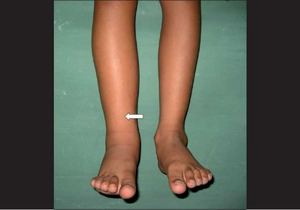Lymphedema–distichiasis syndrome
| Lymphedema–distichiasis syndrome | |
|---|---|
| Other names: Lymphedema with distichiasis[1] | |
 | |
| Lymphedema–distichiasis syndrome is inherited in an autosomal dominant manner | |
Lymphedema–distichiasis syndrome is a medical condition associated with the FOXC2 gene.[2]: 849 People with this hereditary condition have a double row of eyelashes, which is called distichiasis, and a risk of swollen limbs due to problems in the lymphatic system.
Symptoms and signs

The main symptoms of lymphedema-distichiasis are limb swelling and a double row of eyelashes. [3]
Symptoms that have been noted in some but not all cases include cysts, light sensitivity, cardiac defects, cleft palate, and eye problems such as astigmatism and cornea scarring.[3]
Genetics
Lymphedema-distichiasis is inherited in an autosomal dominant fashion.[4] It is estimated that only ¼ of diagnosed individuals did not inherit the condition but rather acquired the syndrome via a de novo mutation.[5] Symptoms emerge between the life stages of puberty to early adulthood (around 30 years old).[citation needed] This is the result of a mutation in the FOXC2 gene.[3]
Mutations
p.Y41F, a missense mutation, is also located in FOXC2 AD-1. p.Y41F is one of eleven mutations found in the FOXC2 gene. It was determined that of these 11 mutations, one was nonsense, six were missense, and four were frameshift mutations.[6]
Diagnosis
Currently, the most accurate test to determine if an individual is affected by lymphedema-distichiasis syndrome is done via Sanger sequencing, which includes whole genome analysis and single gene and multigene testing.[4][7] Sequenced DNA that exhibits mutations in the FOXC2 gene are considered confirmed clinical diagnoses. In addition to Sanger sequencing, Multiplex Ligation Probe Amplification (MLPA) can be used to determine if duplications and deletions in FOXC2 are present in an individual, making it a practical testing mechanism.[4] Lastly, diagnosis is sometimes determined without genome testing. If an individual exhibits multiple symptoms of lymphedema-distichiasis and has a medical history consistent with known lymphedema-distichiasis symptoms, then their diagnosis is confirmed via clinical evaluation.[8]
Treatment
Lymphedema-distichiasis is a rare genetic disease, it is unknown how many individuals are affected and what the frequency of the condition is.[9] As a result, there are few syndrome management techniques: Symptoms of distichiasis can be minimized via eyelash plucking, electrolysis and other various treatments.[7] Limb swelling can be reduced using compression clothing and bandages. Lastly, rapid treatment of broken skin and cellulitis lessens severity of symptoms.[7]
See also
Notes
- ↑ "Lymphedema-distichiasis syndrome | Genetic and Rare Diseases Information Center (GARD) – an NCATS Program". rarediseases.info.nih.gov. Archived from the original on 21 April 2019. Retrieved 21 April 2019.
- ↑ James, William D.; Berger, Timothy G.; et al. (2006). Andrews' Diseases of the Skin: clinical Dermatology. Saunders Elsevier. ISBN 978-0-7216-2921-6.
- ↑ 3.0 3.1 3.2 Fang, Jianming; Dagenais, Susan L.; Erickson, Robert P.; Arlt, Martin F.; Glynn, Michael W.; Gorski, Jerome L.; Seaver, Laurie H.; Glover, Thomas W. (December 2000). "Mutations in FOXC2 (MFH-1), a Forkhead Family Transcription Factor, Are Responsible for the Hereditary Lymphedema-Distichiasis Syndrome". The American Journal of Human Genetics. 67 (6): 1382–1388. doi:10.1086/316915. ISSN 0002-9297. PMC 1287915. PMID 11078474.
- ↑ 4.0 4.1 4.2 Rakhmanov, Yeltay; Maltese, Paolo Enrico; Paolacci, Stefano; Marinelli, Carla; Bertelli, Matteo (2018-09-01). "Genetic testing for lymphedema-distichiasis syndrome". The EuroBiotech Journal. 2 (s1): 13–15. doi:10.2478/ebtj-2018-0026. ISSN 2564-615X. Archived from the original on 2020-11-30. Retrieved 2021-01-01.
- ↑ Kolin, Talia (1991-07-01). "Hereditary Lymphedema and Distichiasis". Archives of Ophthalmology. 109 (7): 980. doi:10.1001/archopht.1991.01080070092042. ISSN 0003-9950. PMC 6693661. PMID 2064580.
- ↑ van Steensel, M.A.M.; Damstra, R.J.; Heitink, M.; Bladergroen, R.S.; Veraart, J.; Steijlen, Peter M.; van Geel, M. (December 2009). "Novel missense mutations in theFOXC2gene alter transcriptional activity". Human Mutation. 30 (12): E1002–E1009. doi:10.1002/humu.21127. ISSN 1059-7794. PMID 19760751.
- ↑ 7.0 7.1 7.2 Mansour, Sahar; Brice, Glen W.; Jeffery, Steve; Mortimer, Peter (1993), Adam, Margaret P.; Ardinger, Holly H.; Pagon, Roberta A.; Wallace, Stephanie E. (eds.), "Lymphedema-Distichiasis Syndrome", GeneReviews®, University of Washington, Seattle, PMID 20301630, archived from the original on 2020-10-01, retrieved 2020-04-15
- ↑ "Lymphedema-Distichiasis Syndrome". NORD (National Organization for Rare Disorders). Archived from the original on 2020-10-19. Retrieved 2020-04-15.
- ↑ Reference, Genetics Home. "Lymphedema-distichiasis syndrome". Genetics Home Reference. Archived from the original on 2020-04-23. Retrieved 2020-04-15.
References
- Mangion J, Rahman N, Mansour S, Brice G, Rosbotham J, Child A, Murday V, Mortimer P, Barfoot R, Sigurdsson A, Edkins S, Sarfarazi M, Burnand K, Evans A, Nunan T, Stratton M, Jeffery S (1999). "A gene for lymphedema-distichiasis maps to 16q24.3". Am J Hum Genet. 65 (2): 427–32. doi:10.1086/302500. PMC 1377941. PMID 10417285.
External links
| Classification | |
|---|---|
| External resources |